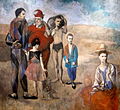
Pablo Ruiz Picasso was a Spanish painter, sculptor, printmaker, ceramicist, and theatre designer who spent most of his adult life in France. One of the most influential artists of the 20th century, he is known for co-founding the Cubist movement, the invention of constructed sculpture, the co-invention of collage, and for the wide variety of styles that he helped develop and explore. Among his most famous works are the proto-Cubist Les Demoiselles d'Avignon (1907) and the anti-war painting Guernica (1937), a dramatic portrayal of the bombing of Guernica by German and Italian air forces during the Spanish Civil War.
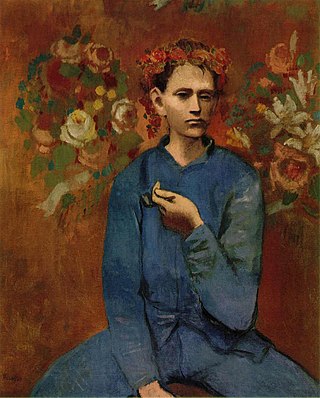
Garçon à la Pipe is an oil on canvas painting by Pablo Picasso. It was painted in 1905 when Picasso was 24 years old, during his Rose Period, soon after he settled in the Montmartre area of Paris. The painting depicts a Parisian adolescent boy who holds a pipe in his left hand and wears a garland of flowers on his head, surrounded by two floral decorations. The subject was a local boy named "P’tit Louis" who died at a young age. The painting is listed as one of the most expensive paintings, after being sold at Sotheby's auction for $104 million on 5 May 2004. It is currently the fifth highest selling painting by Picasso.

Les Demoiselles d'Avignon is a large oil painting created in 1907 by the Spanish artist Pablo Picasso. Part of the permanent collection of the Museum of Modern Art in New York, it portrays five nude female prostitutes in a brothel on Carrer d'Avinyó, a street in Barcelona, Spain. The figures are confrontational and not conventionally feminine, being rendered with angular and disjointed body shapes, some to a menacing degree. The far left figure exhibits facial features and dress of Egyptian or southern Asian style. The two adjacent figures are in an Iberian style of Picasso's Spain, while the two on the right have African mask-like features. Picasso said the ethnic primitivism evoked in these masks moved him to "liberate an utterly original artistic style of compelling, even savage force” leading him to add a shamanistic aspect to his project.

The Rose Period comprises the works produced by Spanish painter Pablo Picasso between 1904 and 1906. It began when Picasso settled in Montmartre at the Bateau-Lavoir among bohemian poets and writers. Following his Blue Period – which depicted themes of poverty, loneliness, and despair in somber, blue tones – Picasso's Rose Period represents more pleasant themes of clowns, harlequins and carnival performers, depicted in cheerful vivid hues of red, orange, pink and earth tones.
The Blue Period comprises the works produced by Spanish painter Pablo Picasso between 1901 and 1904. During this time, Picasso painted essentially monochromatic paintings in shades of blue and blue-green, only occasionally warmed by other colors. These sombre works, inspired by Spain and painted in Barcelona and Paris, are now some of his most popular works, although he had difficulty selling them at the time.

Jeune garçon au cheval is an oil on canvas painting by Pablo Picasso. The painting is housed in the Museum of Modern Art in New York. It was painted in Picasso's Rose Period from 1905 to 1906, when he was still a struggling artist living in Paris. The painting is a study for a much larger composition that Picasso never completed.

The Actor is an oil-on-canvas painting by Spanish painter Pablo Picasso, created from 1904 to 1905. The painting dates from the artist's Rose Period. It is housed in the collection of the Metropolitan Museum of Art in New York City.
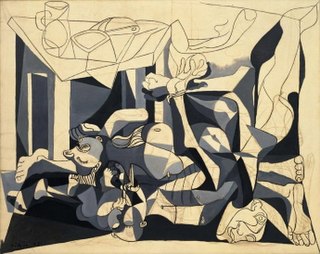
The Charnel House is an unfinished 1944–1945 oil and charcoal on canvas painting by Spanish artist Pablo Picasso, which is purported to deal with the Nazi genocide of the Holocaust. The black and white 'grisaille' composition centres on a massed pile of corpses and was based primarily upon film and photographs of a slaughtered family during the Spanish Civil War. It is considered to be the second of three major anti-war Picassos, preceded by Guernica in 1937 and succeeded by Massacre in Korea in 1951. The painting is housed in the Museum of Modern Art in New York City.

Family of Saltimbanques is a 1905 oil on canvas painting by Pablo Picasso. The work depicts six saltimbanques, a kind of itinerant circus performer, in a desolate landscape. It is considered the masterpiece of Picasso's Rose Period, sometimes called his circus period. The painting is housed in the collection of the National Gallery of Art in Washington, D.C.
Saltimbanco was a Cirque du Soleil show which ran from 1992 to 2006 in its original form.

En premiär is an artwork by Swedish artist Anders Zorn, with several versions created from 1888 to 1895. The work was one of several works in which Zorn depicted woman bathing outdoors, a genre he described as "naked studies in the open". In this composition, a nude woman holding a small child at the edge of the water beside a beach. Different versions are held by the Nationalmuseum in Stockholm, the Ateneum in Helsinki, and the Museum of Fine Arts in Ghent.

Au Lapin Agile is a 1905 oil on canvas painting by Pablo Picasso. It depicts the interior of the Lapin Agile, a famous cabaret club in the Montmartre area of Paris. The composition was produced during Picasso's Rose Period and includes a self-portrait of the artist who frequented the club in his youth. The painting is listed as one of the most expensive paintings after achieving a price of $40.7 million at Sotheby's auction on 27 November 1989. It is housed in the collection of the Metropolitan Museum of Art in New York City.
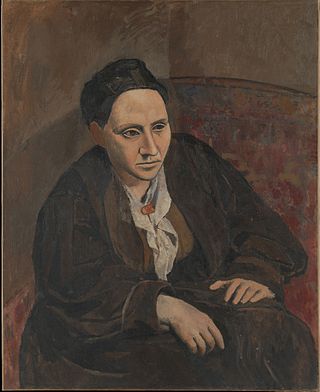
Portrait of Gertrude Stein is an oil-on-canvas painting of the American writer and art collector Gertrude Stein by Pablo Picasso, which was begun in 1905 and finished the following year. The painting is housed in the Metropolitan Museum of Art in New York. It is considered one of the important works of Picasso's Rose Period. The portrait has historical significance, due to the subject's role in Picasso's early life as a struggling artist and eventual commercial success. It also represents a significant transitional step in the artist's move towards Cubism.

Nils Forsberg was a Swedish painter who lived and worked in Paris for much of his career.

Young Girl with a Flower Basket is a 1905 oil on canvas painting by Pablo Picasso from his Rose Period. The painting depicts a Parisian street girl, named "Linda", whose fate is unknown. It was painted at a key phase in Picasso's life, as he made the transition from an impoverished bohemian at the start of 1905 to a successful artist by the end of 1906. The painting is listed as one of the most expensive paintings, after achieving a price of $115 million when it was sold at Christie's on 8 May 2018. It is currently the fourth highest selling painting by Picasso.

Acrobat and Young Harlequin is a 1905 oil on canvas painting by Pablo Picasso. Painted toward the end of Picasso's Blue Period and the outset of his Rose Period, the work displays characteristics of both, with its melancholic subject and its blue and rose palette. Picasso created the painting while at the Le Bateau-Lavoir, his home and studio in Montmartre, Paris.

Girl on a Ball or Young Acrobat on a Ball is a 1905 oil on canvas painting by Pablo Picasso, which he produced during his Rose Period. It depicts a group of travelling circus performers during a rehearsal, with a primary focus on two contrasting figures. It has been housed in the collection of the Pushkin Museum in Moscow since 1948.
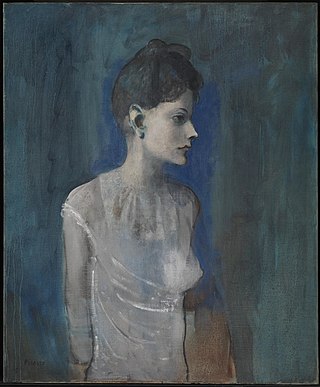
Girl in a Chemise is an oil-on-canvas painting created c. 1905 by Pablo Picasso. It is a portrait of a girl, whom experts believe to be Madeleine, Picasso's girlfriend during this period. Stylistically, the painting belongs to Picasso's Rose Period, although it is predominantly blue in tone. The painting is particularly remarkable for the presence of an earlier portrait of a young boy hidden beneath the surface, which Picasso transformed into the girl by making some subtle changes. The portrait has been housed in the collection of the Tate since 1933.



